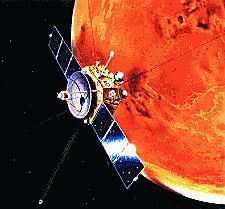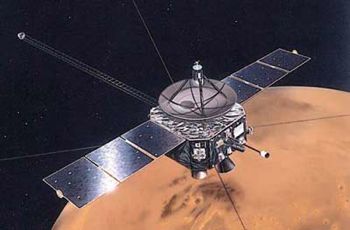
Home - Search - Browse - Alphabetic Index: 0- 1- 2- 3- 4- 5- 6- 7- 8- 9
A- B- C- D- E- F- G- H- I- J- K- L- M- N- O- P- Q- R- S- T- U- V- W- X- Y- Z
Nozomi
 Nozmoi Credit: NASDA |
AKA: Planet-B. Status: Operational 1998. First Launch: 1998-07-03. Last Launch: 1998-07-03. Number: 1 . Gross mass: 258 kg (568 lb). Unfuelled mass: 234 kg (515 lb). Height: 0.58 m (1.90 ft).
Nozomi (Japanese for Hope and known before launch as Planet-B) was to have been a Mars orbiting aeronomy mission designed to study the Martian upper atmosphere and its interaction with the solar wind and to develop technologies for use in future planetary missions. However propulsion failures led to its arrival at Mars being delayed from 1999 to 2003. When it finally arrived at Mars its main engine failed, and the spacecraft passed by 1000 km over the surface and then into solar orbit.
Instruments on the spacecraft were to have measured the structure, composition and dynamics of the ionosphere, aeronomy effects of the solar wind, the escape of atmospheric constituents, the intrinsic magnetic field, the penetration of the solar-wind magnetic field, the structure of the magnetosphere, and dust in the upper atmosphere and in orbit around Mars. The mission also would have returned images of Mars' surface.
The Nozomi orbiter was a 0.58 meter high, 1.6 meter square prism with truncated corners. Extending out from two opposite sides were solar panel wings containing silicon solar cells which provided power to the spacecraft directly or via Ni-MH (nickel metal hydride) batteries. On the top surface was a dish antenna, and a propulsion unit protruded from the bottom. A five meter deployable mast and a 1 meter boom extended from the sides, along with two pairs of thin wire antennas which measured 50 m tip to tip. Other instruments were also arranged along the sides of the spacecraft. Spacecraft communications were via X-band at 8410.93 MHz and S-band at 2293.89 MHz.
The 14 instruments carried on Nozomi were an imaging camera, neutral mass spectrometer, dust counter, thermal plasma analyzer, magnetometer, electron and ion spectrum analyzers, ion mass spectrograph, high energy particles experiment, VUV imaging spectrometer, sounder and plasma wave detector, LF wave analyzer, electron temperature probe, and a UV scanner. The total mass budgeted for the science instruments was 33 kg. Radio science experiments were also possible using the existing radio equipment and an ultra-stable oscillator. The total mass of Nozomi at launch including 282 kg of propellant was 540 kg.
Nozomi used multiple lunar and Earth gravity assist passes to increase its energy for solar orbit insertion and the cruise to Mars. Nozomi was to have been inserted into a highly eccentric Mars orbit with a periapsis 300 km above the surface, an apoapsis of 15 Mars radii, and an inclination of 170 degrees with respect to the ecliptic plane. Shortly after insertion the mast and antennas would have been deployed. The periapsis would then be lowered to 150 km, the orbital period to about 38.5 hours.
The spacecraft would be spin stabilized at 7.5 RPM with its spin axis (and the dish antenna) pointed towards Earth. The periapsis portion of the orbit would have allowed in-situ measurements of the thermosphere and lower exosphere and remote sensing of the lower atmosphere and surface. The more distant parts of the orbit would allow study of the ions and neutral gas escaping from Mars and their interactions with the solar wind.
The nominal mission was planned for one Martian year (approximately two Earth years). An extended mission would have allowed operation of the mission for three to five years. The spacecraft also was to have pointed its cameras at the Martian moons Phobos and Deimos.
NASA NSSDC Master Catalog Description
Efforts to put the Nozomi spacecraft into martian orbit have been abandoned. An attempt to fire thrusters to orient the craft for a Mars orbit insertion burn failed on December 9. The smaller thrusters were successfully fired and Nozomi flew past Mars at a distance of 1000 km on 14 December and went into a heliocentric orbit with a period of roughly two years.
Nozomi (Japanese for Hope and known before launch as Planet-B) was planned as a Mars orbiting aeronomy mission designed to study the martian upper atmosphere and its interaction with the solar wind and to develop technologies for use in future planetary missions. Specifically, instruments on the spacecraft were to measure the structure, composition and dynamics of the ionosphere, aeronomy effects of the solar wind, the escape of atmospheric constituents, the intrinsic magnetic field, the penetration of the solar-wind magnetic field, the structure of the magnetosphere, and dust in the upper atmosphere and in orbit around Mars. The mission would have also returned images of Mars' surface.
Spacecraft and Subsystems
The Nozomi orbiter is a 0.58 meter high, 1.6 meter square prism with truncated corners. Extending out from two opposite sides are solar panel wings containing silicon solar cells which provide power to the spacecraft directly or via Ni-MH (nickel metal hydride) batteries. On the top surface is a dish antenna, and a propulsion unit protrudes from the bottom. A five meter deployable mast and a 1 meter boom extend from the sides, along with two pairs of thin wire antennas which measure 50 m tip to tip. Other instruments are also arranged along the sides of the spacecraft. Spacecraft communications are via X-band at 8410.93 MHz and S-band at 2293.89 MHz. The 14 instruments carried on Nozomi are an imaging camera, neutral mass spectrometer, dust counter, thermal plasma analyzer, magnetometer, electron and ion spectrum analyzers, ion mass spectrograph, high energy particles experiment, VUV imaging spectrometer, sounder and plasma wave detector, LF wave analyzer, electron temperature probe, and a UV scanner. The total mass budgeted for the science instruments is 33 kg. Radio science experiments will also be possible using the existing radio equipment and an ultrastable oscillator. The total mass of Nozomi at launch including 282 kg of propellant was 540 kg.
Mission Profile
After launch on an M-V-3 launch vehicle Nozomi was put into an elliptical geocentric parking orbit with a perigee of 340 km and an apogee of 400,000 km. The spacecraft used a lunar swingby on 24 September and another on 18 December, 1998 to increase the apogee of its orbit. It swung by Earth on 20 December 1998 at a perigee of about 1000 km. The gravitational assist from the swingby coupled with a 7 minute burn of the bipropellant engine put Nozomi into an escape trajectory towards Mars. It was scheduled to arrive at Mars on 11 October 1999 at 7:45:14 UT, but a malfunctioning valve during the Earth swingby resulted in a loss of fuel and left the spacecraft with insufficient acceleration to reach its planned trajectory. Two course correction burns on 21 December used more propellant than planned, leaving the spacecraft short of fuel.
The new plan was for Nozomi to remain in heliocentric orbit for an additional four years, including two Earth flybys in December 2002 and June 2003, and encounter Mars at a slower relative velocity in December 2003. On 21 April 2002 as Nozomi was approaching Earth for the gravity assist maneuver, powerful solar flares damaged the spacecraft's onboard communications and power systems. An electrical short was caused in a power cell used to control the attitude control heating system which allowed the hydrazine fuel to freeze. The fuel thawed out as the craft approached Earth and maneuvers to put the craft on the correct trajectory for its Earth flyby were successful. Another Earth flyby within 11000 km occurred on 19 June 2003. The fuel had completely thawed out for this manuever because of the spacecraft's proximity to the Sun. However, on 9 December 2003, efforts to orient the craft to prepare it for a 14 December main thruster orbital insertion burn failed, and efforts to save the mission were abandoned. The small thrusters were fired on December 9 moving the closest approach distance to 1000 km. The spacecraft flew by Mars on 14 December 2003 and went into a roughly 2-year heliocentric orbit.
Nozomi was to be inserted into a highly eccentric Mars orbit with a periapsis 300 km above the surface, an apoapsis of 15 Mars radii, and an inclination of 170 degrees with respect to the ecliptic plane. Shortly after insertion the mast and antennas were to be deployed. The periapsis would have been lowered to 150 km, the orbital period to about 38.5 hours. The spacecraft was to be spin stabilized at 7.5 RPM with its spin axis (and the dish antenna) pointed towards Earth. The periapsis portion of the orbit would have allowed in-situ measurements of the thermosphere and lower exosphere and remote sensing of the lower atmosphere and surface. The more distant parts of the orbit would be for study of the ions and neutral gas escaping from Mars and their interactions with the solar wind. The nominal mission was planned for one martian year (approximately two Earth years). An extended mission might have allowed operation of the mission for three to five years. The spacecraft was also to point its cameras at the martian moons Phobos and Deimos.
Family: Mars orbiter. Country: Japan. Launch Vehicles: Mars tactical rocket, M-V. Projects: Mars. Launch Sites: Kagoshima, Kagoshima M-V. Agency: ISAS, NEC. Bibliography: 2, 296, 6741, 12890.
 | Nozomi Credit: Manufacturer Image |
1998 July 3 - . 18:12 GMT - . Launch Site: Kagoshima. Launch Complex: Kagoshima M-V. Launch Vehicle: M-V.
- Nozomi - .
Mass: 258 kg (568 lb). Nation: Japan.
Agency: ISAS.
Manufacturer: NEC.
Class: Mars.
Type: Mars probe. Spacecraft: Nozomi.
USAF Sat Cat: 25383 . COSPAR: 1998-041A. Apogee: 489,381 km (304,086 mi). Perigee: 703 km (436 mi). Inclination: 27.30 deg. Period: 20,910.00 min.
Originally known as Planet-B; renamed Nozomi ('Hope') after launch. The third stage and payload entered a 146 x 417 km x 31.1 deg parking orbit. The KM-V1 kick (fourth) stage then fired to place the spacecraft into a circumlunar 359 x 401491 km x 28.6 deg orbit. Nozomi made multiple lunar and Earth gravity assist passes to increase its energy for solar orbit insertion and the cruise to Mars.. The spacecraft used a lunar swingby on 24 September and another on 18 December 1998 to increase the apogee of its orbit. It swung by Earth on 20 December at a perigee of about 1000 km. The gravitational assist from the swingby coupled with a 7 minute burn of the bipropellant engine put Nozomi into an escape trajectory towards Mars. It was scheduled to arrive at Mars on 11 October 1999 at 7:45:14 GMT, but the Earth swingby left the spacecraft with insufficient acceleration and two course correction burns on 21 December used more propellant than planned, leaving the spacecraft short of fuel. The new plan is for Nozomi to remain in heliocentric orbit for an additional four years and encounter Mars at a slower relative velocity in December 2003.
2002 December 20 - .
2003 June 19 - .
2003 December 14 - .
- Nozomi, Mars Flyby - .
Nation: Japan.
Spacecraft: Nozomi.
The Japanese Mars probe, Nozomi, flew past the planet at a height of 1000 km. Attempts to operate the spacecraft's main propulsion system failed, and small thrusters were used to increase the flyby distance by about 100 km to ensure a clean miss. The mission was abandoned, and Nozomi entered a new orbit around the Sun.
Back to top of page
Home - Search - Browse - Alphabetic Index: 0- 1- 2- 3- 4- 5- 6- 7- 8- 9
A- B- C- D- E- F- G- H- I- J- K- L- M- N- O- P- Q- R- S- T- U- V- W- X- Y- Z
© 1997-2019 Mark Wade - Contact
© / Conditions for Use